
Inexorable progress requires more and more performance from computers.The Internet is fast
TP-Link has developed a whole line of routers that support Wi-Fi 6 (at the momentThe company's website mentions 12 such models, of which 5 are available in Ukraine.This review is dedicated to the most powerful, fastest, and (which is quite logical) the most expensive model – the Archer AX11000, made in a bright gamer design.However, there are not many client devices with Wi-Fi 6 yet, so especially for this testing in the editorial officeggI was given a test Samsung Salaxy S20 Ultra 5G (aka SM-G988B/DS).
Appearance, equipment, ergonomics
New flagship Archer, like other top onesThe company's routers have rather large dimensions - its dimensions with installed antennas are 29x29x18 cm. It is not surprising - for three transceivers and a powerful processor, a lot of space is required, both for placement and for normal ventilation. Almost the entire bottom wall of the case and about half of the area of the top are perforated. That is, the efficiency of passive cooling is maximum, but nothing prevents dust and moisture from getting inside. Both desktop and wall-mountable (in any orientation). In a large bright box, the router itself, 8 antennas, a power supply and a patch cord are neatly packed.
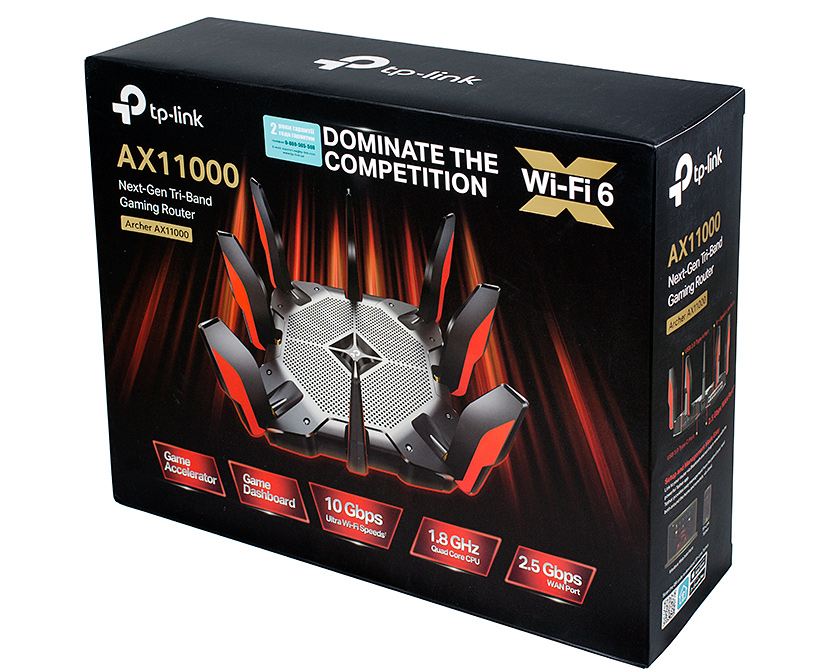
</ img>

</ img>

</ img>

</ img>

</ img>

</ img>

</ img>

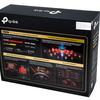





The plastic case is almost all matte, except forseveral decorative glossy elements. In the center of the top panel there is a large LED indicator in the form of the company logo - unobtrusive, but clearly visible. It is the only one, but multifunctional - it blinks yellow during bootup, is constantly white in operating mode when Wi-Fi is on and yellow when it is off, and when there is no Internet connection, it glows red.




The detachable black and red antennas with a single operating position give the router an aggressive look in the typical gaming style - with them, the AX11000 looks like some kind of hellfire.


On the front wall of the case there is a block ofthree small and not illuminated buttons - WPS, turning off Wi-Fi and the indicator. The rear wall is completely occupied - it houses a connector and power switch, a hidden reset button, a WAN input port (2.5 Gbps) and 8 Gigabit LAN ports, two of which can operate in Link Aggregation mode, that is, for communication with another network device via two channels at once - to increase throughput or redundancy. This is no longer quite a home or gaming application, however, if we abstract from the design, nothing prevents the use of the AX11000 in a “serious” local network of a small office or enterprise. On one of the side walls there are two USB 3.0 ports, one of which is USB-A format, and the second is USB-C.



Performance, functionality, interface
Traditionally, the number in the model name meansthe total bandwidth of the router's wireless channels. Like other top-end TP-Link models, the AX11000 has three Wi-Fi operating bands. One transceiver operates at 2.4 GHz and is capable of passing through itself up to 1148 Mbps of data per second, the other two operate in the 5 GHz range and can pump up to 4804 Mbps each. Up to 12 data transmission channels with the width of each channel up to 160 MHz can be used simultaneously. It is clear that these are purely theoretical values for ideal conditions, however, testing has shown a significant increase in throughput compared to routers of the IEEE 802.11ac / n standard. Of course, the already familiar MU-MIMO technologies are supported for the simultaneous transmission of data to several client devices, Beamforming (concentration of signal power in the direction of the client) and Airtime Fairness (more efficient distribution of time slots allocated to each device depending on its performance). A novelty of the Wi-Fi 6 standard is the use of OFDMA technology, based on the OFDM signal modulation method (dividing the radio spectrum into several subcarriers, each of which carries its own information stream). This method is also successfully used in LTE networks. Moreover, OFDMA works in all Wi-Fi bands. Thus, a 2.4 GHz network, which has a larger coverage area than 5 GHz, becomes one and a half to two times faster, which is good for using the router in large rooms. In addition, the use of OFDMA reduces latency, which is very important in games. And the use of BSS Color packet identifier allows clients to ignore packets from third-party networks operating in the same range, which can reduce interference and minimize data transmission delays.
Powerful 64-bit controls all this beauty4-core processor with a frequency of 1.8 GHz, so when working in a room with a temperature of 22-25 ° C, the router heats up noticeably. It is powered by an external 60 W power supply (12V, 5A).

</ img>

</ img>
The router was tested in the general officearea of about 300 sq. m with a large number of internal walls and partitions. The router was connected to the gigabit segment of the local network, the maximum speed of the Internet connection is in the screenshot below. The Wi-Fi channel width was selected automatically by the router (as configured by default) and was 20 MHz for a 2.4G network and 80 MHz for a 5G network. Stable communication was provided at a distance of up to 20-25 m through 2-3 interior walls. At the same time, the subnet with the word “Gaming” in SSID it was received noticeably better, although the settings of both 5 GHz bands are the same.


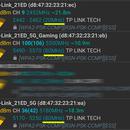
At a distance of 25 m through 4 walls, the smartphone in the list of available networks showed only 2 subnets - 2.4 GHz and 5 GHz with the Gaming index, although everything was displayed in the Wi-Fi Analyzer:

</ img>
Internet access speed testing (Speedtest)
- next to the router:

</ img>

</ img>

</ img>



- 15 m and 2 walls from the router (for some reason, one of the 5G subnets was unavailable here):

</ img>
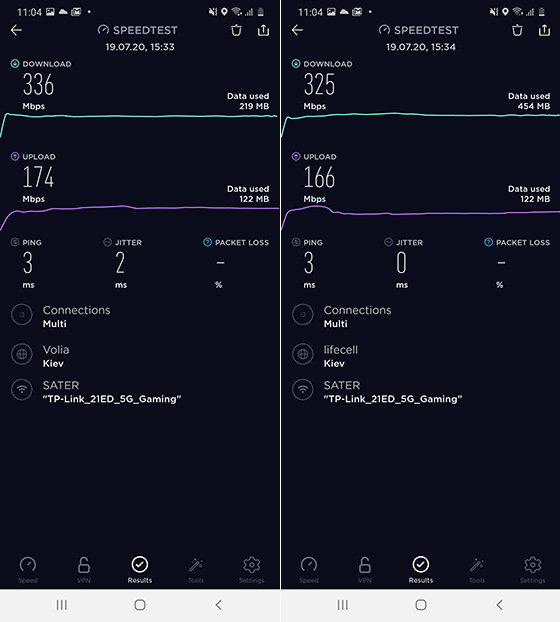
</ img>


- 20 m and 3 walls:

</ img>

</ img>

</ img>



- 25m and 4 walls (one of the 5G networks is not available):

</ img>

</ img>


- 30 m and 4 walls - networks are not available for connection
When the 40 MHz channel width was turned on for the 2.4 GHz band, the speed practically did not change (measured only next to the router, compare with the results of the first test above):

In the 5 GHz bands, the choice of value "160" for the "Channel Width" parameter did not give anything, the channel width remained 80 GHz.
Based on testing paired with Galaxy S20 Ultrathe Wi-Fi coverage of the AX11000 seemed to be slightly smaller compared to other routers from the company that I tested in the same office. But, as it turned out, several other smartphones of colleagues in the office see the test network from a greater distance than the test Galaxy, that is, everything is in order with the router. But for the first time I managed to get a Wi-Fi speed of up to 700 Mbps, perhaps it would have been even higher if the channel to the provider allowed.
The router's web interface has been noticeably redesignedcompared to previous models that we tested. Black and red colors support the visual style of the product, but are a little tiring - the readability of red text on a black background is worse than black on white. The organization of the menu has also changed: now it is divided into pages-sections by functionality, and not by “complexity level”, as before. The least popular settings are placed on a separate Advanced page. The name of the Game Center section is a little confusing, from which you expect something special, but in fact it contains already familiar tools – QOS, parental controls, antivirus, etc. True, there is a new option for me called Game accelerator, the inclusion of which should reduce delays and speed up games, but I was not able to feel the effect of its inclusion.







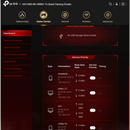








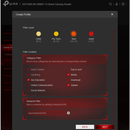








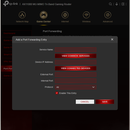












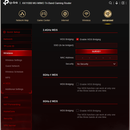













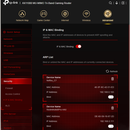










The branded Tether app for Android looks in the same style, only to access the advanced settings, you need to follow the link to the mobile version of the same web interface.























In the dry residue
The Archer AX11000 is certainly impressive.Both in appearance and unprecedented wireless connection speeds. This is a real flagship, the most productive and functional, today even slightly ahead of its time, since there are still few client devices with Wi-Fi 6. Its price (15,000 UAH) is high at first glance, but it’s worth comparing it with the cost of a modern gaming computer, laptop and a couple of top-end smartphones - and it will turn out to be quite logical and affordable for those who really need such a monster.
3 reasons to buy Archer AX11000:
- you have (or are planning to purchase) devices with Wi-Fi 6 support;
- you need a router that can provide a large number of high-speed connections (including wired ones), and Wi-Fi 6 support will come in handy in the near future;
- you are used to not denying yourself anything and buy only top-end equipment.
1 reason not to buy the Archer AX11000:
- the power and functionality of this model is clearly overkill for your needs.
TP-Link Archer AC11000 router specifications
Interface
8 10/100/1000 Mbps LAN ports, Link Aggregation (802.3ad) two LAN ports)
1 WAN port 10/100/1000/2500 Mbps
1 x USB-A 3.0 and 1 x USB-C 3.0
Dimensions
288 x 288 x 184 mm
Power supply
external, 12 V, 5 A
Wireless Standards
IEEE 802.11ax/ac/n/a 5 GHz
IEEE 802.11ax / n / b / g 2.4 GHz
Transfer speed
5 GHz-1: up to 4804 Mbps
5 GHz-2: up to 4804 Mbps
2.4 GHz: up to 1148 Mbps
Wireless security
Encryption modes: WEP, WPA, WPA2, WPA/WPA2-Enterprise (802.1x)
Support for technologies that improve the area and quality of Wi-Fi coverage
8 antennas; 4x4 MU-MIMO; Beamforming, OFDMA, Airtime Fairness, DFS
WAN connection type
Dynamic IP/Static IP/PPPoE/PPTP (Dual Access)/L2TP (Dual Access)
DHCP
Server, client, DHCP client list, address reservation
Port Forwarding
Port Triggering, UPnP, DMZ
Dynamic DNS
TP-Link DDNS, DynDns, NO-IP
Protocols
IPv4 and IPv6 support
USB sharing
Samba (storage device) / FTP server / Time Machine support, NTFS, exFAT, HFS +, FAT32 file system support
VPN server
PPTP, Open VPN Server

TP-LINK Archer AX11000
Top Wi-Fi router with Wi-Fi 6 support
This is an older model of Wi-Fi router for everyone who is notused to deny myself nothing. Inside the case with eight antennas placed around its perimeter and giving it a frankly predatory look, there are three transceivers operating in two bands and a 4-core processor. All modern (and even ahead of time) technologies are supported: from MU-MIMO 4x4 and IPv6 to Wi-Fi 6 and Beamforming, which allows you to create a focused signal in an area requiring increased consumption of a wireless Internet connection ... All of this, along with ease of control and customization, deserves an editorial "we recommend" award.
buy at M.Video
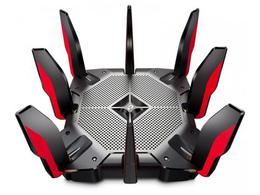
we recommend